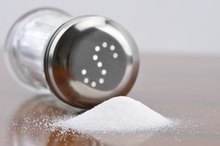What does fact checked mean?
At Healthfully, we strive to deliver objective content that is accurate and up-to-date. Our team periodically reviews articles in order to ensure content quality. The sources cited below consist of evidence from peer-reviewed journals, prominent medical organizations, academic associations, and government data.
- Harvard School of Public Health: Lower Salt and Sodium: A Key to Good Health
- Harvard School of Public Health: Tasting Success with Cutting Salt
The information contained on this site is for informational purposes only, and should not be used as a substitute for the advice of a professional health care provider. Please check with the appropriate physician regarding health questions and concerns. Although we strive to deliver accurate and up-to-date information, no guarantee to that effect is made.
How Much Sodium Is There in Seasoning Salt?
Seasoning salt contains a lot of sodium. The popular spice blend is a mainstay in many kitchens, and if you’re using seasoning salt regularly, chances are you are getting more than the recommended amount of sodium. Although your body needs some salt, too much salt is linked with high blood pressure, which in turn ups your risk of heart disease and stroke. Lesser known is too much salt is also associated with osteoporosis and some cancers. Do yourself a favor and make your own seasoning salt to control how much sodium you are getting.
Seasoning Salt
Seasoning salt is also sometimes called seasoned salt 1. The main ingredient of this commercial product is salt but it also includes a blend of spices and herbs. These usually include onions, pepper, garlic and paprika. It’s commonly used to enhance the flavor of foods, especially meat and poultry, as well as French fries and some side dishes.
- Seasoning salt is also sometimes called seasoned salt 1.
- These usually include onions, pepper, garlic and paprika.
Lawry’s, Morton and Badia
The Vitamin C in Onions
Learn More
Lawry’s Seasoned Salt, Morton Seasoned Salt, Morton Season-All Brand Seasoned Salt and Badia Seasoned Salt are among the many popular brands of seasoning salt 1. Each contains comparable amounts of sodium. In their Nutrition Facts label, they each use one-quarter of a teaspoon as their serving size. For example, Lawry’s has 380 mg of sodium in a single serving. Morton has 350 mg per serving and Badia has 380 mg. Some of the salt-makers produce a lower-sodium version of their regular seasoning salt.
- Lawry’s Seasoned Salt, Morton Seasoned Salt, Morton Season-All Brand Seasoned Salt and Badia Seasoned Salt are among the many popular brands of seasoning salt 1.
- In their Nutrition Facts label, they each use one-quarter of a teaspoon as their serving size.
Salt Intake Recommendations
It’s no secret Americans consume too much salt and therefore get way more sodium than is necessary — or healthy. You do need some. The Institute of Medicine recommends 2,300 mg daily for most healthy Americans, but only 1,500 for those with health issues such as hypertension and diabetes. The average American gets about 3,400 mg daily, reports Harvard University’s School of Public Health.
- It’s no secret Americans consume too much salt and therefore get way more sodium than is necessary — or healthy.
- The average American gets about 3,400 mg daily, reports Harvard University’s School of Public Health.
Reduce Your Salt — Make Your Own Seasoned Salt
Can Eating Salt Prevent Weight Loss?
Learn More
You can reduce your intake of sodium by reducing your portion sizes, eating fewer processed foods and eating more fresh fruit and vegetables. In addition, you don’t have to rely on commercial products to get seasoning salt. You can make your own and control how much salt goes in. For example you could combine lower-sodium salts with more of your own fresh herbs and spices. One word of caution: talk to your doctor before you use salt substitutes. You may get excessive amounts of potassium and cause other health problems.
- You can reduce your intake of sodium by reducing your portion sizes, eating fewer processed foods and eating more fresh fruit and vegetables.
- You can make your own and control how much salt goes in.
Related Articles
References
Resources
Writer Bio
Angela Ogunjimi has been a prize-winning writer and editor since 1994. She was a general assignment reporter at two newspapers and a business writer at two magazines. She writes on nutrition, obesity, diabetes and weight control for a project of the National Institutes of Health. Ogunjimi holds a master's degree in sociology from George Washington University and a bachelor's in journalism from New York University.









